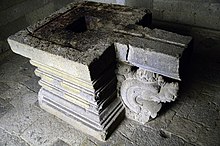Yoni
The yoni (f., Sanskrit योनि yoni , lit.: origin) is the tantric term for the female genitalia ( vulva , vagina and uterus ) and is also used in western neotantra . In addition, the word has many meanings, all of which have sexual implications: source, origin, resting place, container, whereabouts, loophole, nest, etc. a.
history
Lingam - and yoni-like representations can be found - even if only sporadically and not very concise - in the Indus culture ( Harappa , Mohenjo-Daro ). An assumed continuity to the later Hindu conceptions and representations is rather speculative. (see also: Mohenjo-Daro Siegel 420 )
distribution
Lingam and yoni representations are common throughout India, Nepal, and the Hindu-influenced areas of Southeast Asia.
function
The yoni serves as a collecting basin and as a drainage channel for liquids (water, coconut milk, melted butter), which are poured out over the lingam as an adoring offering. In older temples, the drainage channel is extended outwards through a hole in the temple wall.
Representations
The yoni is usually designed as a round or square horizontal plate with a central indentation or notches on the edge and a lateral spout. In older temples this plate also forms part of the floor of the temple interior; later the yoni plate and lingam were raised by a base. Lingam and yoni are mostly shown together; Individual finds are very rare and usually do not correspond to the original condition.
symbolism
While the round shape of the representation - combined with the likewise round lingam - comes close to a circular shape, which in many cultures was associated with the infinity of heaven, creation and the world of gods, the square representation of the yoni evokes associations with the limitation of the earth or the earthly awake. The union of the square yoni and the round lingam can thus also be understood as a union or overcoming of opposing principles (earth - sky; woman - man).
meaning
Together with the lingam - often interpreted as a stylized phallus - the yoni in Hinduism , especially in Shaivism , is a symbol of divine creative energy. The fusion of Shiva and his Shakti (see also Devi ), the female energy, finds its immediate mystical and artistic expression in the representation of Lingam and Yoni. In neo-tantra ( yoni massage ) and especially in tantra , the feminine, symbolized by Shakti, receives special attention.
literature
- Anneliese and Peter Keilhauer: The Imagery of Hinduism. The Indian world of gods and their symbolism. DuMont, Cologne 1986 pp. 167 ff., ISBN 3-7701-1347-0
- David Kinsley: Indian Goddesses. Female deities in Hinduism. Insel Verlag, Frankfurt 1990, pp. 75 ff., ISBN 3-458-16118-X
Web links
Individual evidence
- ↑ David Kinsley: Indian Goddesses. Female deities in Hinduism. Insel Verlag, Frankfurt 1990, p. 290 ISBN 3-458-16118-X


